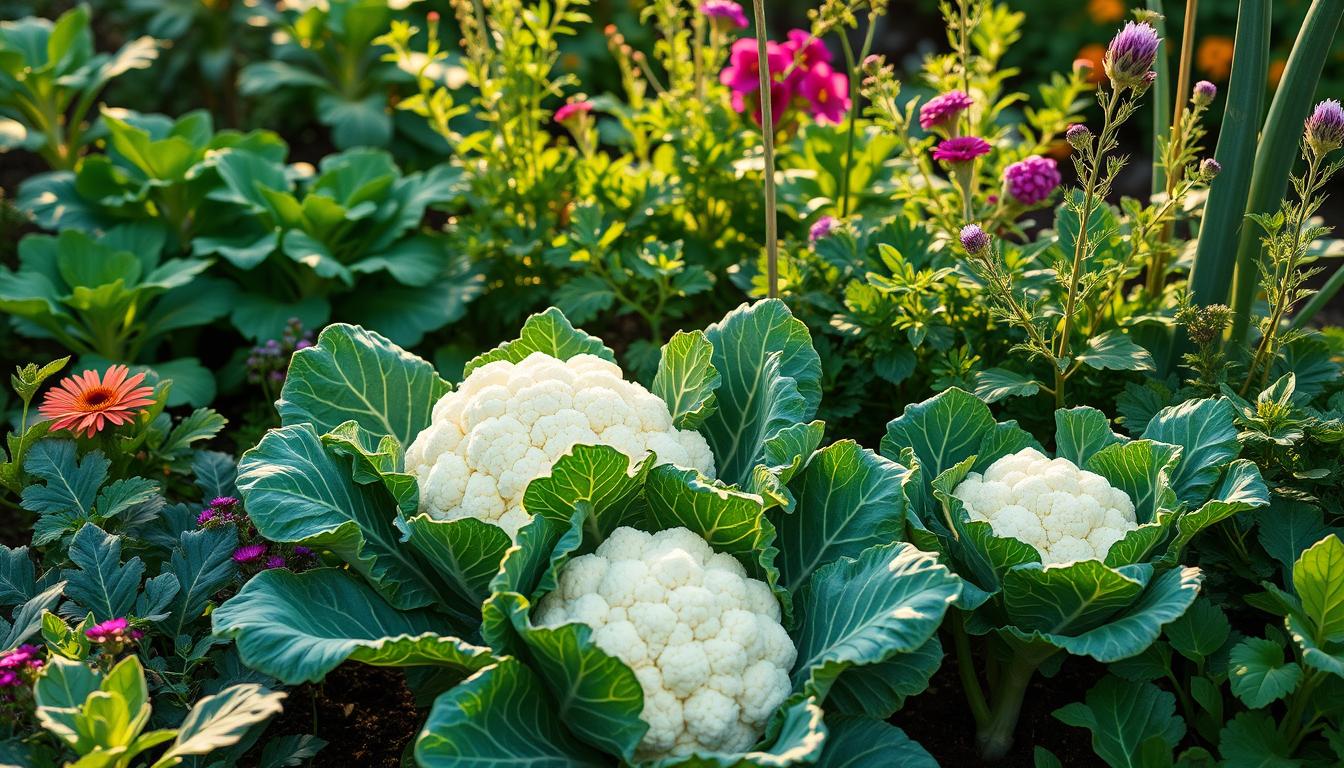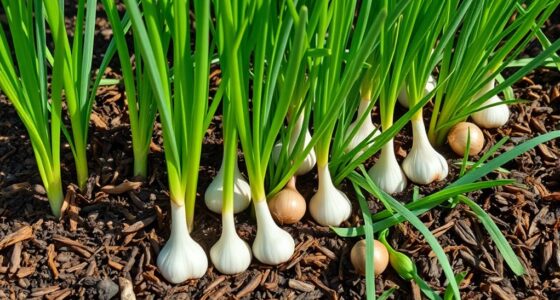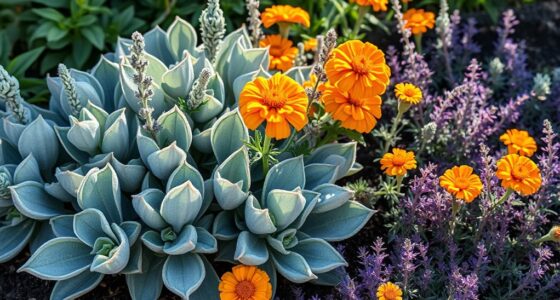Imagine stepping into your garden, the air rich with the scent of earth and greenery. You run your fingers through the vibrant leaves of your plants and feel a sense of connection deeply rooted in this shared journey of growth. Companion planting with cauliflower can transform your gardening experience, enhancing not only the health of your crops but also the joy you feel every time you harvest. Selecting the best companion plants for cauliflower can create a thriving ecosystem in your vegetable patch, ensuring it’s a place where both you and your plants flourish. Let’s explore how these remarkable relationships can unlock the full potential of your garden.
Key Takeaways
- Companion planting with cauliflower enhances growth and deters pests.
- The right partners can significantly boost productivity in your garden.
- Selecting the best companion plants for cauliflower nurtures plant health.
- Creating a vibrant garden fosters a deeper connection with nature.
- Understanding plant relationships leads to a more successful growing season.
Why Companion Planting Matters for Cauliflower
Understanding the significance of companion planting can significantly enhance your gardening experience, especially with cauliflower. Utilizing this method contributes to maximizing space and promoting overall growth. It also plays a crucial role in reducing pest damage, enabling you to cultivate a healthier garden.
The Benefits of Companion Planting
The benefits of companion planting extend beyond simple aesthetics. By carefully choosing your cauliflower garden companions, you can create a vibrant ecosystem that supports stronger plants. Companion planting with cauliflower encourages plants to thrive collectively, drawing from each other’s nutrient needs and growth patterns. This teamwork leads to healthier harvests, making your gardening efforts more fruitful.
How Companion Plants Improve Growth
Employing companion plants can dramatically improve growth. For instance, celery interplanted with cauliflower can enhance nutrient uptake, as it efficiently utilizes water and enjoys the benefits of the nutrients released by cauliflower. This symbiotic relationship not only optimizes the usage of garden space but also helps both plants flourish more robustly.
Pest Control Through Companion Relationships
When it comes to pest control and companion plants, some varieties naturally deter harmful insects. Allium species such as garlic are excellent choices, as they release compounds that effectively mask the scent of cauliflower. This aromatic barrier can fool pests like cabbage moths, protecting your crops from potential damage. By strategically planting these companions, you enhance the resilience of your cauliflower against common garden threats.

Ideal Companion Plants for Cauliflower
Choosing the right cauliflower plant companions can significantly enhance your garden’s overall health and productivity. Certain plants thrive alongside cauliflower, creating a supportive environment for growth and pest management. This section provides insights into ideal cauliflower companion plants to include in your gardening strategy.
Leafy Greens: Lettuce and Spinach
Leafy greens like lettuce and spinach are excellent cauliflower plant companions. Their shallow root systems allow them to coexist without competing for nutrients, while the shade provided by cauliflower helps keep these greens cool during warmer weather. Including these plants in your garden can promote a productive microclimate beneficial for all.
Fragrant Herbs: Basil and Dill
Herbs such as basil and dill serve critical roles in your cauliflower companion planting guide. The aroma of basil acts as a natural deterrent against various pests, making it an invaluable ally for cauliflower. Dill, on the other hand, not only attracts beneficial pollinators but also invites natural predators that control harmful pest populations, ensuring your cauliflower remains healthy.
Resilient Flowers: Marigolds and Nasturtiums
Flowers like marigolds and nasturtiums enrich your garden’s ecosystem. Marigolds repel nematodes, enhancing soil quality, while nasturtiums function as trap crops, luring pests away from your cauliflower. Their vibrant colors not only enhance the visual appeal of your garden but also attract beneficial insects, supporting a thriving companion planting environment.
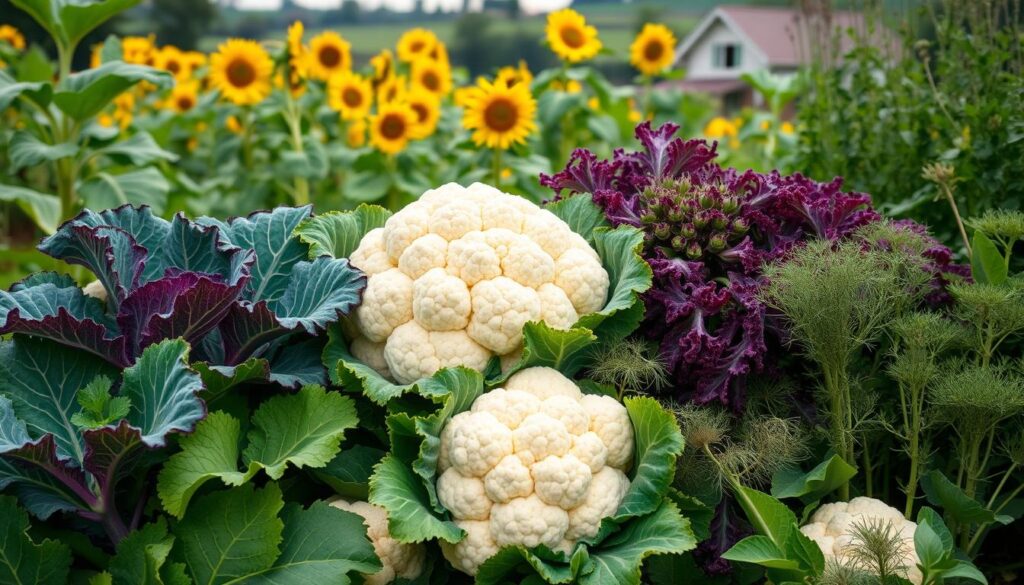
Plants to Avoid Near Cauliflower
When planning your garden, it’s essential to know which plants to avoid near cauliflower. Some plants can have detrimental effects on cauliflower neighbors, hindering growth and overall health. Understanding these relationships ensures your crops thrive.
Detrimental Neighbors: Beans and Tomatoes
Beans and tomatoes are two common plants to avoid near cauliflower. These crops can compete for vital nutrients and moisture, leading to stunted cauliflower development. Beans, particularly, release compounds that negatively affect brassicas like cauliflower, resulting in lower yields. Tomatoes demand significant nutrients, which can deplete the soil and leave cauliflower lacking essential resources. Keeping these plants away helps safeguard your cauliflower’s health.
Why Certain Plants Stunt Growth
Competition for nutrients is a primary reason for the stunted growth of cauliflower when grown near certain plants. When similar crops share space, they often compete for the same essential nutrients. The result can be a lack of vital resources for cauliflower plants, ultimately impacting their growth. Scouting your garden for these competitive plants can lead to healthier cauliflower crops.
Recognizing Signs of Plant Stress
As you cultivate your garden, it’s crucial to recognize signs of plant stress in companion planting. Yellowing leaves, reduced growth, and lower yields can indicate that your cauliflower is facing problems. If you notice these symptoms, consider reassessing the arrangement of your vegetable garden. By identifying stress early, you can make the necessary adjustments to improve your planting strategy and enhance overall garden health.
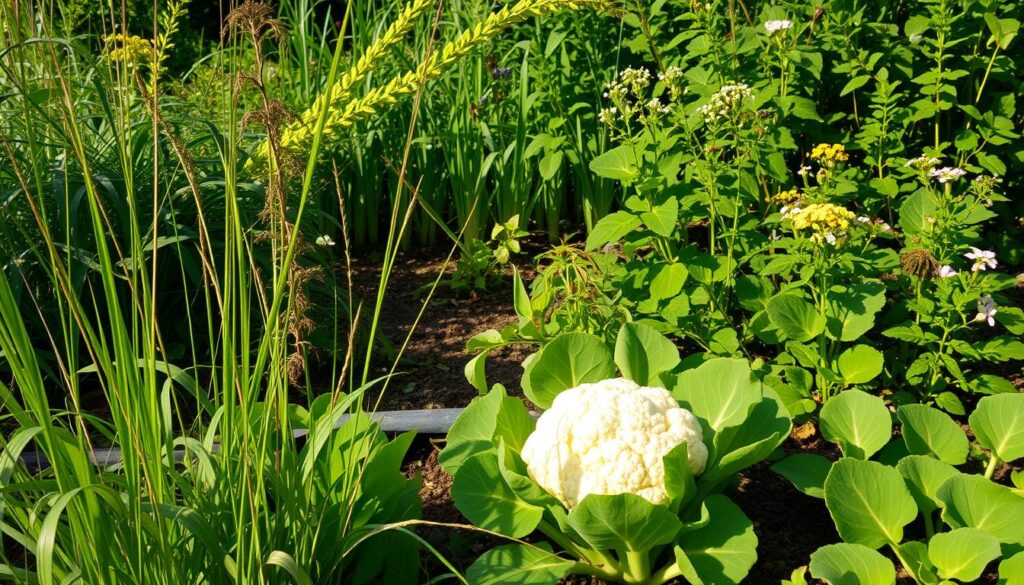
Planting Techniques for Cauliflower Companions
Utilizing effective planting techniques can significantly enhance your gardening experience, especially when working with cauliflower and its companions. By employing intercropping, succession planting, and proper spacing, you can ensure a thriving garden filled with healthy, productive plants. Let’s explore how to integrate these strategies into your gardening routine.
Intercropping Strategies
Intercropping and companion plants for cauliflower involve planting alongside compatible species to maximize space and resources. This method not only increases diversity but also promotes healthier plant growth. For instance, pairing cauliflower with herbs like basil or dill can create an environment that enhances flavor while deterring pests. This planting technique aids in making the most out of limited garden space and can lead to a bountiful harvest.
Succession Planting Tips
Practicing succession planting for best yield is an effective way to maintain a steady supply of fresh produce throughout the growing season. By planting fast-growing companions such as radishes or lettuce alongside cauliflower, you free up space for subsequent crops as the cauliflower matures. This approach allows you to maximize your yield and reduce waste in your garden while ensuring various levels of growth are present at all times.
Spacing Considerations for Optimal Growth
Proper spacing for cauliflower and its companions is crucial to prevent crowding and allow each plant the room to thrive. Aim to plant cauliflower with at least 18 to 24 inches of space between plants to accommodate their size and root systems. For companion plants, adjust spacing according to their growth habits, ensuring they do not compete for resources. Adequate spacing supports healthy development, leading to robust crops and a vibrant garden.
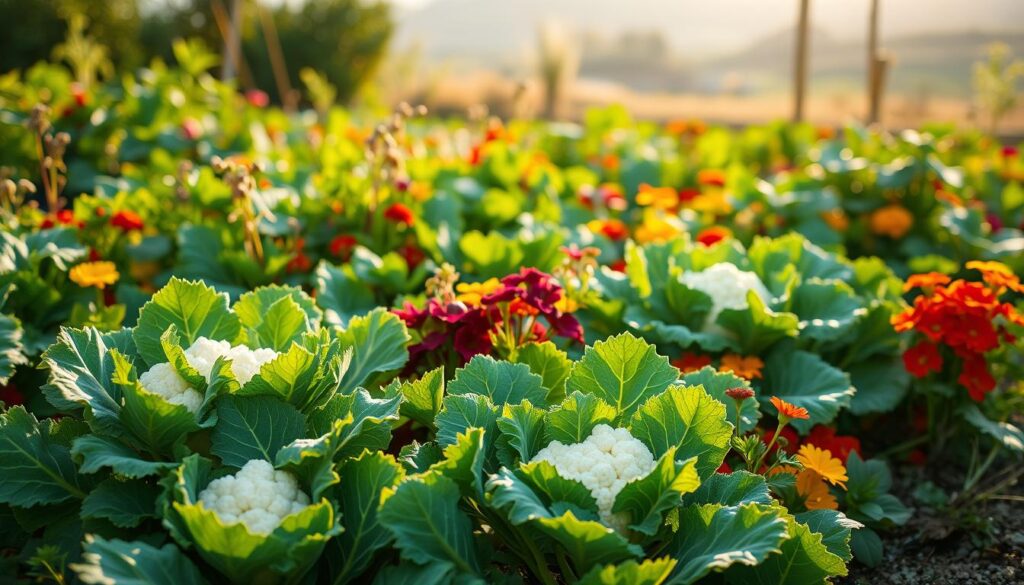
Nutrient Needs of Cauliflower and Companions
Understanding the nutrient requirements of cauliflower and its companions can significantly enhance your garden’s productivity. Healthy soil plays a crucial role in ensuring that these plants receive the vital nutrients they need throughout their growth cycle. Let’s explore how to optimize soil health for cauliflower companions, effective fertilization practices, and the benefits of encouraging microbial activity.
Understanding Soil Health
Soil health is foundational for your companion planting efforts. A thriving ecosystem begins with rich, well-aerated soil, improving nutrient availability for both cauliflower and its partners. You can achieve this by incorporating organic matter, which provides essential nutrients and creates a balanced structure that supports healthy root systems.
Fertilization Tips for Companion Gardens
To meet the fertilization and nutrient needs of cauliflower and its companions, apply a balanced fertilizer mixture that caters to their specific requirements. Regular applications throughout the growing season ensure that these plants have access to the nutrients they need to flourish. Consider conducting a soil test to tailor your fertilization strategy more precisely to your garden’s conditions.
Microbial Activity and Root Solutions
Promoting healthy microbial activity within the soil will provide numerous microbial activity benefits. When plant roots release natural compounds, they nourish beneficial microbes that enhance nutrient uptake. This symbiotic relationship not only improves the overall health of your plants but also fosters resilience against pests and diseases.
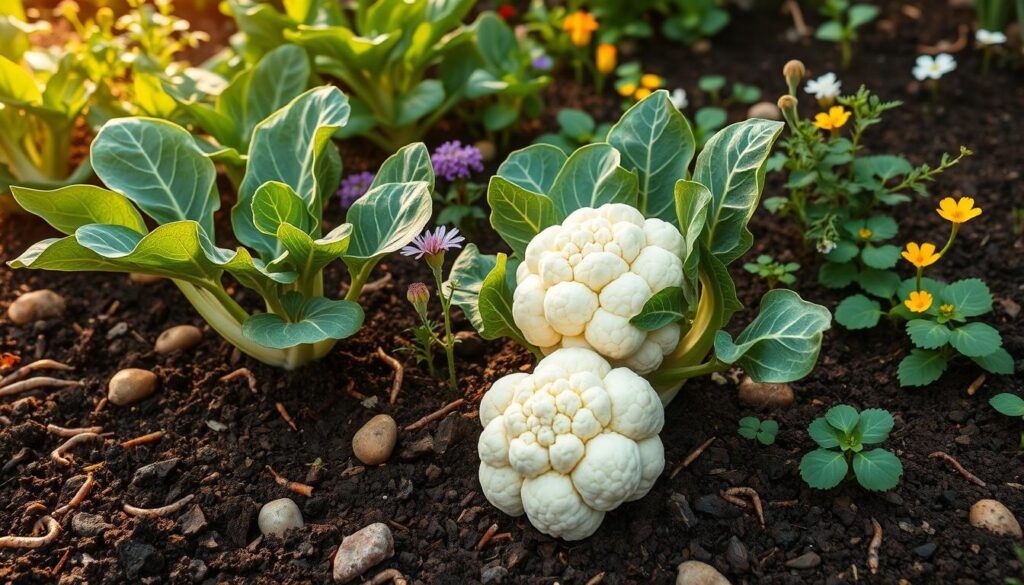
Seasonal Considerations for Cauliflower Companions
Understanding the seasonal aspects of planting can significantly impact the success of your cauliflower garden. Each season brings unique opportunities and challenges for optimal growth. You should focus on timing your planting and companion choices to align with seasonal changes.
Spring Planting Guidelines
Spring planting for cauliflower begins with preparing the soil as temperatures begin to rise. Aim for early spring for planting both cauliflower and its companions. Ensure the soil temperature reaches an adequate level for seed germination. You may consider incorporating cold-tolerant plants alongside cabbage, like onions or garlic to establish a thriving garden right from the start.
Summer Planting Strategies
As summer arrives, employ effective summer companion planting tips for your cauliflower. Choose companions such as corn, which provides shade to protect cauliflower from the intense heat. Consistent watering becomes crucial during this period, as soil can dry out quickly. Pairing with heat-resistant plants like squash or peppers can also ensure your cauliflower flourishes.
Preparing for Fall Harvests
Fall harvest preparation involves strategic planting later in the season. Consider varieties of cauliflower that mature during cooler temperatures, complemented by companion crops like kale or Brussels sprouts. This approach not only maximizes your yields but also assures you have a bountiful harvest that continues through the fall months.

Creating a Diverse Garden with Companion Plants
Embracing biodiversity in gardening can transform your cauliflower planting into a thriving ecosystem. A well-planned garden layout attracts beneficial insects while fostering plant health, making natural pest control possible. Integrating diverse companion plants supports your cauliflower and enriches the overall garden environment.
Benefits of Biodiversity
Incorporating a variety of plant species enhances soil health and pest management. Different plants bring unique nutrients to the soil and create habitats for essential insects. This diversity can lead to a more resilient garden, allowing for improved growth and yield.
How to Plan Your Companion Layout
Effective planning is crucial when designing your companion layout for cauliflower. Assess the heights of plants to maximize sunlight exposure and consider their nutrient requirements and growth schedules. This thoughtful organization ensures that all plants harmonize well together, which is essential for a flourishing garden.
Seasonal Rotation for Healthier Soil
Implementing seasonal rotation practices is vital for maintaining robust soil. Rotating crops minimizes nutrient depletion and keeps pests at bay. For optimal soil enrichment, it is beneficial to follow brassicas like cauliflower with legumes, which naturally replenish soil nutrients.

Companion Planting Mistakes to Avoid
Gardening with a companion planting approach can lead to lush and productive plots. Misunderstandings often create challenges, like incorrectly pairing plants or disregarding their specific needs. Recognizing these common mistakes in companion planting can significantly enhance your gardening outcomes.
Common Misunderstandings
One prevalent misconception is that all plants can thrive together. Every species has unique requirements and compatibility considerations. For instance, grouping plants with similar nutrient needs might lead to deficiencies. Researching compatibilities helps avoid these common mistakes in companion planting, promoting healthier garden environments.
Signs Your Companions Aren’t Thriving
Keeping an eye on your garden allows you to notice issues before they escalate. Signs such as wilting foliage, stunted growth, or overall low vigor indicate the possible presence of unhealthy companion plants. Timely recognition of these signals enables you to address problems early and consider adjusting gardening strategies. Observing these signs promotes a flourishing garden atmosphere, blending your plants harmoniously.
Learning from Mistakes: Adjusting Your Garden
Every gardener encounters setbacks at times. Embracing these moments as learning opportunities helps refine your approach. Evaluate your choices regularly and don’t hesitate to modify plant pairings based on what you observe. By actively adjusting your gardening strategies, you enhance the potential of companion planting, fostering an environment where every plant can thrive.

Enhancing Pollinator Populations
Attracting pollinators to your garden plays a significant role in not only the health of your plants but also in the overall productivity of your garden. A diverse array of flowers can draw in bees and butterflies, which are essential for pollination, especially for crops like cauliflower. By implementing specific strategies, you can ensure that these beneficial insects have a reliable source of nectar throughout the growing season.
Attracting Bees and Butterflies
To enhance your garden’s pollinator populations, focus on incorporating plants that specifically attract bees and butterflies. Flowers like yarrow, lavender, and sunflowers are excellent choices. These species are known for their ability to draw various beneficial insects, ensuring a vibrant ecosystem in your garden. By choosing flowers for pollinators, you create a welcoming environment where these insects thrive, increasing pollination rates for your vegetable crops.
Selecting Pollinator-Friendly Flowers
When selecting flowers, prioritize native species that are already adapted to your local environment. Native plants require less maintenance and are more likely to attract the right types of pollinators. Consider incorporating a mix of early, mid, and late-blooming plants. This variety ensures that you provide continuous blooms, which is vital for attracting pollinators to your garden throughout the growing season.
Timing Blooms to Support Cauliflower
Understanding blooming times for optimal impact is crucial when planting companion flowers. Plan your planting schedule to create a steady supply of blossoms. This strategy supports not only your cauliflower plants but also enhances the availability of food sources for pollinators at different times. By aligning your flowering plants with the growth stages of cauliflower, you maximize pollinator activity when your crops need it the most.

Organic Pest Control with Companion Plants
Embracing organic pest control methods enhances the sustainability of your garden while keeping pest populations at bay. Implementing specific plants that deter pests allows you to create a resilient ecosystem. These companion plants not only function as deterrents but also improve overall plant health.
Utilizing Companion Plants for Deterrence
Certain herbs, such as sage and rosemary, possess natural properties that repel various pests. Planting these alongside cauliflower can help maintain a healthy garden environment without resorting to synthetic chemicals. Besides, they add aromatic beauty to your space and can serve culinary purposes.
Natural Predators: Encouraging Beneficial Insects
Creating an inviting habitat for beneficial insects in your garden is essential. Flowers that attract ladybugs, lacewings, and parasitic wasps can naturally control pest populations, which often threaten cauliflower crops. Encouraging beneficial insects in your garden diminishes your reliance on harmful substances while promoting a balanced ecosystem.
Traditional Methods to Manage Pest Issues
Combining traditional pest control practices like crop rotation and companion planting contributes to a more diverse garden, ultimately leading to healthier plants. By understanding which plants pair well together, you can craft a pest management strategy that reduces the chances of infestations. Such practices foster a robust environment where plants thrive and produce abundant harvests.
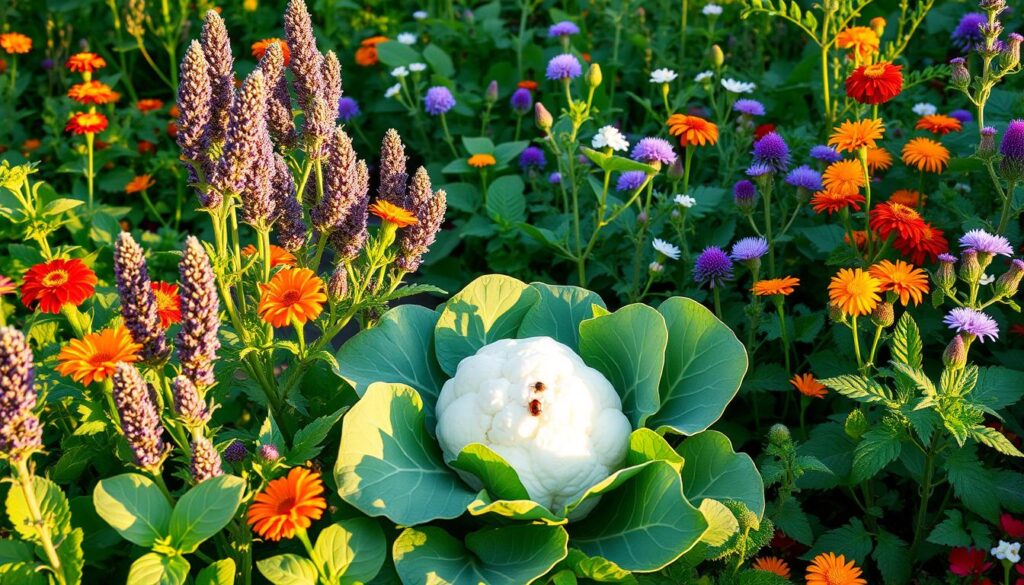
Harvesting and Maintaining Your Cauliflower Garden
Proper techniques for harvesting and maintaining your cauliflower garden can significantly improve your results. Using effective harvesting cauliflower tips ensures you get the best quality produce while caring for your plants helps prepare your garden for next season.
Best Practices for Harvesting
When it comes time to harvest, look for firm and compact heads. Use sharp garden tools to make clean cuts, which minimizes damage to surrounding plants. This careful approach not only preserves your crops but also allows for optimal storage conditions post-harvest.
Plant Care Post-Harvest
After harvesting, focus on the post-harvest care for cauliflower. Maintaining soil moisture is crucial, as it supports the health of remaining plants. Additionally, managing weed growth ensures that nutrients can reach your soil and plants effectively, setting the stage for future growth.
Preparing for Next Season’s Garden
As you start planning for your next planting cycle, consider conducting soil tests. This strategy helps identify which nutrients were depleted during the growing season. Amending the soil according to these findings is essential. Thoughtful planning of your future companion plant arrangements will lead to a thriving garden in the upcoming season.
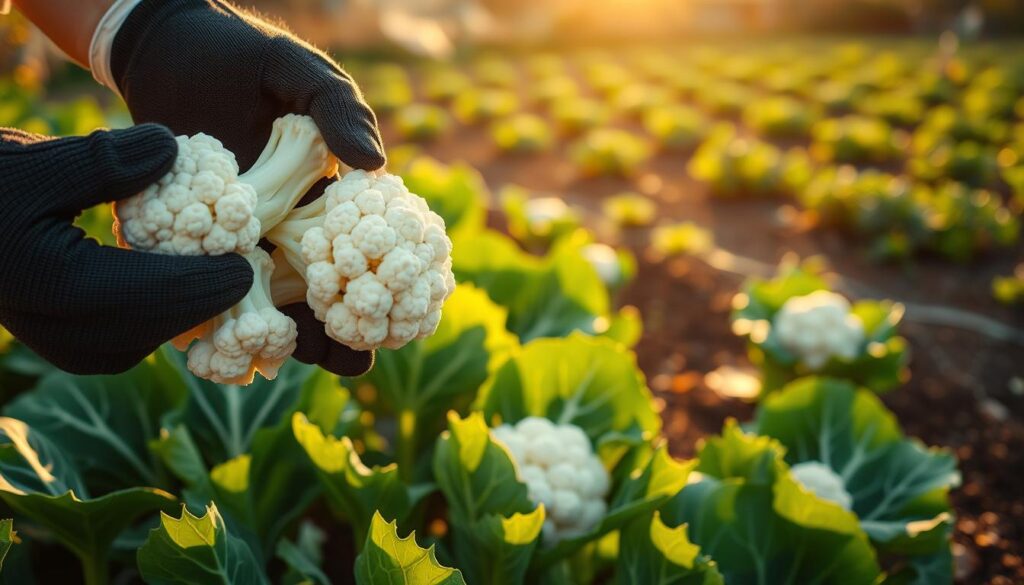
Resources for Companion Planting
Expanding your knowledge about companion planting can greatly enhance your gardening experience. A variety of resources are available that you can utilize to deepen your understanding and improve your garden’s health. Engaging with relevant literature, online communities, and local groups can provide valuable insights and practical tips.
Books for Further Reading
Delve into various companion planting literature to enrich your gardening techniques. Notable books, such as “The Garden Primer” and “Carrots Love Tomatoes,” provide essential advice and methods on how to effectively implement companion planting strategies. These resources often contain detailed explanations and illustrations, making it easier to apply the concepts in your own garden.
Online Gardening Communities
Participating in gardening forums and communities allows you to connect with other enthusiasts. Here, you can share your experiences, seek advice, and gather insights on different companion planting techniques. Many online platforms host discussions about specific challenges and successes, creating a supportive environment for gardeners at all skill levels.
Local Gardening Clubs and Workshops
Joining local gardening resources, such as clubs or workshops, brings a hands-on learning experience. These gatherings often provide specialized workshops focused on companion planting and other techniques tailored to your region’s climate and soil conditions. Networking with fellow gardeners may also assist you in fine-tuning your gardening practices for better results.

Real-Life Success Stories
Exploring case studies in gardening success offers valuable insights into the world of companion planting with cauliflower. You might find inspiration from the experiences of other gardeners, providing you creative ideas and effective techniques for your own garden. Tapping into personal gardeners’ stories can enrich your understanding and may lead to improved growing outcomes.
Successful Gardens: Case Studies
Several dedicated gardeners have documented their journeys with companion planting, showcasing how they improved their cauliflower yields. One notable case involved a community garden in Seattle, where members successfully paired cauliflower with marigolds. This strategic selection not only deterred pests but also enhanced overall growth. Another case study from a suburban garden in Texas highlighted the benefits of planting basil alongside cauliflower, boosting the flavor and promoting healthy plant interactions.
Personal Experiences from Fellow Gardeners
Many gardeners have shared their personal experiences with companion planting, revealing the triumphs and trials of their gardens. A local farmer in California recounted his trials with different plant pairings and discovered the power of lettuce as a companion. He noticed improved soil moisture levels around the cauliflower, demonstrating a smart use of space and resources. Such gardeners’ stories remind you that experimentation often leads to rewarding results.
Tips From the Experts
Expert gardening advice frequently emphasizes the importance of careful planning and an understanding of plant interactions. Professionals recommend starting with a small section of your garden when experimenting with new companion plants. Regular observation can help you gauge what works best for your specific conditions. Listening to experts can provide additional insights into creating successful combinations that maximize your cauliflower harvest.
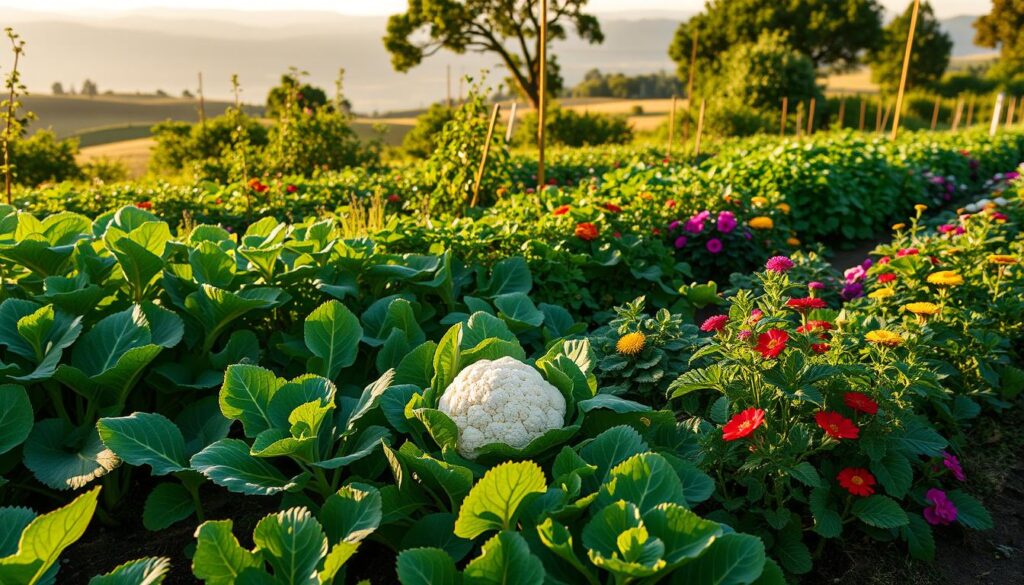
| Gardener’s Location | Companion Plants Used | Benefits Observed |
|---|---|---|
| Seattle, WA | Marigolds | Improved pest control and growth |
| Texas | Basil | Enhanced flavor and healthy interactions |
| California | Lettuce | Better soil moisture retention |
Encouraging Experimentation in Your Garden
One of the most rewarding aspects of gardening is the opportunity to experiment with companion plants. Trying new companion combinations can lead to surprising results that enhance your garden’s health and productivity. Don’t hesitate to mix and match plants to discover what works best for your unique garden environment. The joy of seeing how different plants interact and support each other can be a game-changer in your gardening journey.
To make the most of your gardening experience, consider documenting garden progress in a journal. Keeping track of what you plant, when you plant it, and the outcomes of your experiments will provide valuable insights. By noting the successes and failures of your companion plants, you can refine your approach and improve future harvests. This methodical record-keeping will empower you to make informed decisions throughout the growing season.
Lastly, sharing gardening successes with others can create a vibrant learning community. Whether you join local gardening groups or engage with fellow enthusiasts online, sharing your experiences fosters a supportive environment. Not only can you gain insights from others’ successes, but your own discoveries may inspire them in their gardening adventures. Embrace the spirit of collaboration as you grow, learn, and experiment with your garden.
